
Malva is a genus of herbaceous annual, biennial, and perennial plants in the family Malvaceae. It is one of several closely related genera in the family to bear the common English name mallow. The genus is widespread throughout the temperate, subtropical and tropical regions of Africa, Asia and Europe.

Malva moschata, the musk mallow or musk-mallow, is a species of flowering plant in the family Malvaceae, native to Europe and southwestern Asia, from Spain north to the British Isles and Poland, and east to southern Russia and Turkey. Growing to 60 cm (24 in) tall, it is a herbaceous perennial with hairy stems and foliage, and pink saucer-shaped flowers in summer.
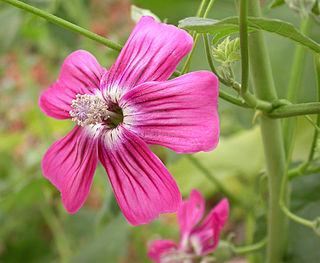
Malva assurgentiflora, formerly classified as Lavatera assurgentiflora, the island mallow, mission mallow, royal mallow, malva rosa island mallow, island tree mallow or malva rosa in Spanish, is a species of flowering plant in the mallow family.

Veronica agrestis, the green field-speedwell is a species of flowering plant in the Plantaginaceae (Plantain) family. It is native to Europe, western Asia and North Africa, and has been introduced to eastern North America, India and some other countries.

Veronica polita, the grey field-speedwell is a species of flowering plant in the Plantaginaceae (Plantain) family. It is native to Europe, southwestern Asia, North Africa, the Arabian Peninsula and a few nearby countries, and has been introduced to many countries worldwide particularly as a weed of cultivation.

Malva alcea is a plant in the mallow family native to southwestern, central and eastern Europe and southwestern Asia, from Spain north to southern Sweden and east to Russia and Turkey.
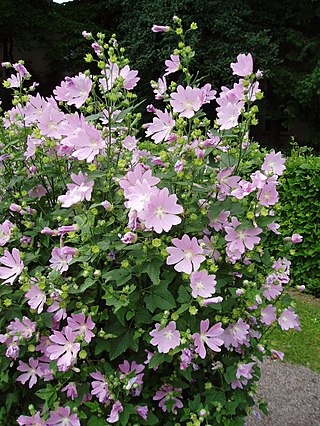
Malva thuringiaca, the garden tree-mallow, is a species of flowering plant in the mallow family Malvaceae, native to eastern Europe and southwestern Asia, from southern Germany south to Italy, and east to southern Russia, Kazakhstan, and Turkey.

Malva arborea, the tree mallow, is a species of mallow native to the coasts of western Europe and the Mediterranean region, from Ireland and Britain south to Algeria and Libya, and east to Greece.

Malva sylvestris is a species of the mallow genus Malva in the family of Malvaceae and is considered to be the type species for the genus. Known as common mallow to English-speaking Europeans, it acquired the common names of cheeses, high mallow and tall mallow as it migrated from its native home in Western Europe, North Africa and Asia through the English-speaking world.

Malva neglecta is a species of plant of the family Malvaceae, native to most of the Old World except sub-Saharan Africa. It is an annual growing to 0.6 m (2 ft). It is known as common mallow in the United States and also as buttonweed, cheeseplant, cheeseweed, dwarf mallow, and roundleaf mallow. This plant is often consumed as a food, with its leaves, stalks and seed all being considered edible. This is especially true of the seeds, which contain 21% protein and 15.2% fat.
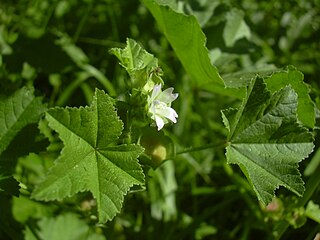
Malva parviflora is an annual or perennial herb that is native to Northern Africa, Southern Europe, and Western and Central Asia and is widely naturalised elsewhere. Common names include cheeseweed, cheeseweed mallow, Egyptian mallow, least mallow, little mallow, mallow, marshmallow, small-flowered mallow, small-flowered marshmallow, Nafa Shak, and smallflower mallow.

Malva multiflora is a species of flowering plant in the mallow family known by the common names Cornish mallow and Cretan hollyhock. It is native to western Europe, North Africa, and the Mediterranean Basin, and it is naturalized in areas with a Mediterranean climate, such as parts of Australia, South Africa, and California. This is an annual or biennial herb growing a tough, somewhat hairy stem to a maximum height between 1 and 3 meters. The leaves are multilobed with flat or wavy edges, slightly hairy, and up to 10 centimeters long. The plant bears small pink or light purple flowers with petals just over a centimeter long. The fruit is disc-shaped with 7 to 10 segments.
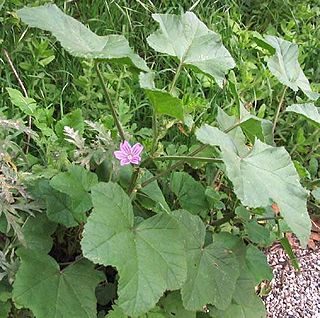
Malva nicaeensis is a species of flowering plant in the mallow family known by the common names bull mallow and French mallow.

Malva punctata, commonly called spotted-stalked tree-mallow or annual tree mallow, is an annual herbaceous plant belonging to the genus Malva of the family Malvaceae.
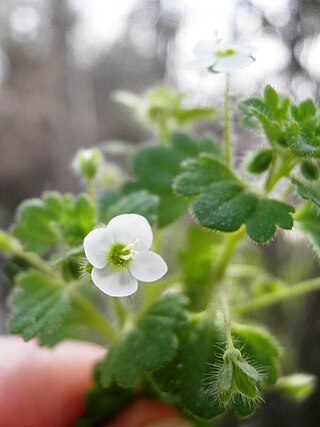
Veronica cymbalaria, the pale speedwell, glandular speedwell or cymbal speedwell is a species of flowering plant in the Plantaginaceae (Plantain) family. It is native to countries surrounding the Mediterranean and a little further afield, and has been introduced to parts of the Americas and New Zealand.
Malvella sherardiana, or Sherard's malvella, is a perennial plant native to Spain and from Greece to Crimea, southeastward to Iran, the only old world species in the genus Malvella.

Alcea digitata, the fingered hollyhock, is a tall hollyhock with large flowers native to the Middle East.
Alcea remotiflora is a species of hollyhock plant native from Turkey to Iran.
Alcea heldreichii is a hollyhock plant native to southwestern Europe and Turkey.
Alcea apterocarpa is a tall hollyhock plant native to Lebanon, Syria, Palestine, the Sinai, and Turkey.















